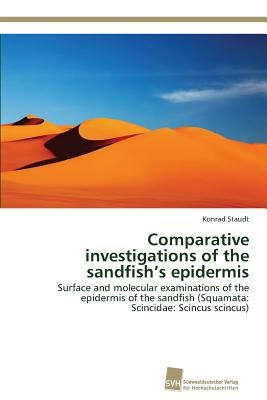
- We will send in 10–14 business days.
- Author: Konrad Staudt
- Publisher: Sudwestdeutscher Verlag Fur Hochschulschriften AG
- Year: 2012
- Pages: 108
- ISBN-10: 3838132262
- ISBN-13: 9783838132266
- Format: 15.2 x 22.9 x 0.7 cm, minkšti viršeliai
- Language: English
- SAVE -10% with code: EXTRA
Comparative investigations of the sandfish's epidermis (e-book) (used book) | bookbook.eu
Reviews
Description
The sandfish (Scincidae: Scincus scincus) is a lizard capable of moving through desert sand in a swimming-like fashion. The epidermis of this lizard shows a low friction to sand as an adaption to a subterranean life below the desert's surface. Caused by material properties of β-keratin proteins forming the outer epidermis, this low friction reduces further adhesive wear. Both skin effects, the friction reduction and abrasion resistance outperform even steel. A possible explanation for these properties is an increased glycosylation of the β-keratins. In this study, the friction and the micro-structure of the epidermis as well as the β-keratin coding DNA and the glycosylation of the β- keratin proteins of the sandfish was investigated in comparison to other sauropsidean species. Glycan based friction reduction could be verified by force-distance measurements via atomic force microscopy: proteins were deglycosylated and the glycans covalently bound on a glass surface by silanisation. Both surfaces showed low adhesion force similar to the untreated skin of the sandfish in comparison to Eumeces schenideri and a glass control.
EXTRA 10 % discount with code: EXTRA
The promotion ends in 21d.11:47:27
The discount code is valid when purchasing from 10 €. Discounts do not stack.
- Author: Konrad Staudt
- Publisher: Sudwestdeutscher Verlag Fur Hochschulschriften AG
- Year: 2012
- Pages: 108
- ISBN-10: 3838132262
- ISBN-13: 9783838132266
- Format: 15.2 x 22.9 x 0.7 cm, minkšti viršeliai
- Language: English English
The sandfish (Scincidae: Scincus scincus) is a lizard capable of moving through desert sand in a swimming-like fashion. The epidermis of this lizard shows a low friction to sand as an adaption to a subterranean life below the desert's surface. Caused by material properties of β-keratin proteins forming the outer epidermis, this low friction reduces further adhesive wear. Both skin effects, the friction reduction and abrasion resistance outperform even steel. A possible explanation for these properties is an increased glycosylation of the β-keratins. In this study, the friction and the micro-structure of the epidermis as well as the β-keratin coding DNA and the glycosylation of the β- keratin proteins of the sandfish was investigated in comparison to other sauropsidean species. Glycan based friction reduction could be verified by force-distance measurements via atomic force microscopy: proteins were deglycosylated and the glycans covalently bound on a glass surface by silanisation. Both surfaces showed low adhesion force similar to the untreated skin of the sandfish in comparison to Eumeces schenideri and a glass control.


Reviews